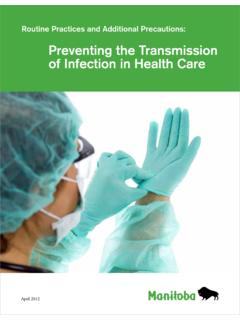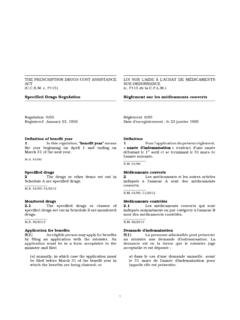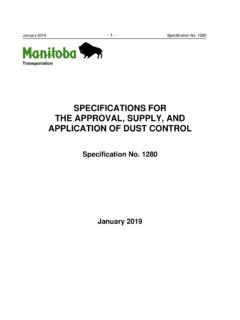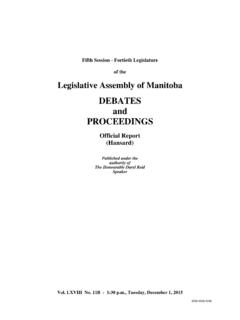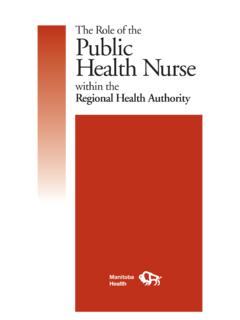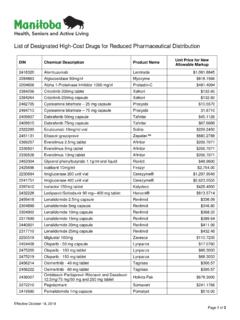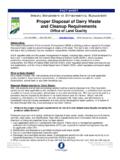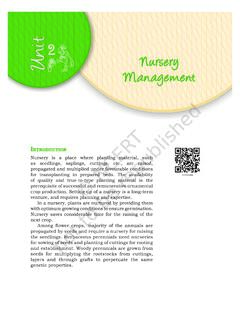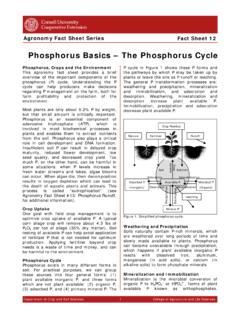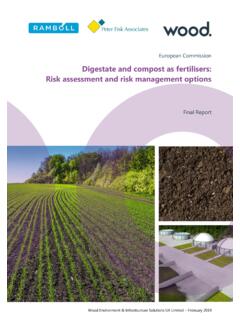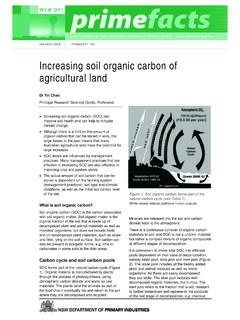Transcription of Properties of Manure - Province of Manitoba
1 Properties of ManureNovember 2015 Properties of Manure | Page iii ContentsLearning Objectives ..1 Overview ..1 Introduction ..1 Factors That Affect Manure Composition ..2 Feeding and Nutrient Excretion ..2 Water Consumption ..3In-Barn Water Use ..3 Livestock Bedding ..3In-Barn Drying Systems ..3 Weather ..4 Manure Storage Design ..4 Microbial Decomposition and other Nutrient and Moisture Transformations ..4 Settling of Solids Liquid Pig Manure ..5 Manure Sampling and Analysis ..8 General Guidelines for Sampling Manure ..8 Sampling Well Agitated Liquid Manure ..10 Sampling Partially Agitated Liquid Manure ..11 Sampling Manure from Multi-Celled Systems ..12 Sampling Solid Manure ..12 Laboratory Analyses for Manure ..13 Rapid In-Field Testing of Liquid Manure ..14 Composition of Typical Manures in Manitoba ..15 Book Values ..15 Moisture and Dry Matter Content ..19 Nitrogen ..19 Carbon to Nitrogen Ratios and Nitrogen Availability from Manure .
2 20 Phosphorus Forms in Manure ..21 Estimated Available N:P2O5 ratios ..22 Potassium ..23 Sulphur ..23 Micronutrients and Other Trace Elements in Manure ..24 Salts in Manure ..24 Page iv | Properties of ManureBy-Products of Manure Treatment ..26 Composting ..26 Solid Liquid Separation ..27 Centrifuge ..27 Rotary Press ..30VP Systems Air Floatation and Belt Filter Press ..32 Gravity Separation ..34 Anaerobic Digestion ..35 References ..36 Appendices ..37 Properties of Manure | Page 1 Learning ObjectivesAfter completing this review, you should be able to explain and/or describe:1. The factors that affect Manure composition2. How to properly sample and ship Manure for analysis 3. The dry matter, nutrient, trace element and salt content of typical Manitoba livestock and poultry manures4. The Properties of various by-products of Manure treated in Manitoba Overview This chapter on Properties of Manure focuses on the characteristics of livestock and poultry Manure that are important for managing Manure in an agronomically and environmentally responsible manner.
3 The factors that influence Manure composition are discussed and typical concentrations are provided for nutrients, trace elements and salts from pig, dairy, beef and layer manures. The characteristics of Manure by-products following treatment are also briefly discussed for a few treatment systems that have been tested in Manitoba . For information about the behavior of nutrients in soil, see the Manitoba Agriculture, Food and Rural Development (MAFRD) publication Effects of Manure and Fertilizer on Soil Fertility and Quality. IntroductionManure is composed of animal feces and urine and may contain livestock bedding, additional water and wasted feed (Figure 1). It is a valuable fertilizer that contains a broad range of nutrients such as nitrogen (N), phosphorus (P) and potassium (K) as well as micronutrients such as copper (Cu), manganese (Mn) and zinc (Zn). Manures with added bedding are also an excellent source of organic matter which improves soil quality when applied to land.
4 The water, nutrient and organic matter contents of manures, however, vary greatly making them more difficult to manage than synthetic fertilizers. MineralsF eed G rains & F orageManureFigure 1 | Manure is composed of feces, urine, bedding, additional water and wasted 2 | Properties of ManureFactors That Affect Manure CompositionThe primary factors that affect nutrient composition of Manure are livestock type, stage of growth and feeding practices (all of which determine nutrient excretion rates) as well as the amount of bedding or water added to the Manure , type of Manure storage, time that the Manure spends in storage and weather conditions. Feeding and Nutrient ExcretionLivestock retain some of the nutrients they are fed as they gain weight. Nutrients are also retained in milk and eggs. Nutrients that are not retained by the animal or exported in livestock products are excreted and end up in the Manure .
5 Livestock typically excrete 50 to 90 % of the nutrients they are fed, depending on the animal species, stage of growth and the ration provided (feed source and supplements). Fully-grown animals that are not gaining weight, gestating or producing milk or eggs, however, excrete almost all of the nutrients they are fed. Feeding nutrients in excess of what the animal requires increases the amounts that are excreted in the feces and urine. The nutrient requirements of livestock are affected by animal species, age, gender and stage of production. For example, animals that are actively growing will require different quantities of nutrients than mature animals. Similarly animals that are lactating require more nutrients than animals that are gestating. Adjusting the feed ration to more accurately provide the nutrients required by the animal such as adjusting for different growth stages, lactation, gestation or gender provides opportunities to reduce the quantity of nutrients excreted in the Manure by reducing the number of periods in which nutrients are overfed.
6 The quality and availability of nutrients in feed affect how much must be fed to meet nutritional requirements and how much will be excreted in the Manure . Feeding high quality protein sources and balancing amino acids allows producers to reduce the amount of N that must be fed and also decreases N excretion. Nitrogen is excreted in both the feces and the urine. Soluble N is excreted in the urine as urea or uric acid; whereas, organically bound N is excreted in the feces. Improving digestibility of the nutrients can also reduce excretion, particularly for P. Most of the plant P in feed grains is in the form of phytate, a very stable molecule. Monogastric animals (such as pigs and chickens) cannot absorb phytate P; therefore, this form of P passes through the gut and is excreted in the feces. The inclusion of microbial phytase in the diets of monogastric animals allows them to absorb phytate P which, in turn, allows for a reduction in supplemental inorganic P in the diet and a reduction of P excreted in the Manure .
7 If more dietary available P is absorbed than is required by the animal, however, the excess P will be extracted by the kidneys and excreted in the urine. Although the quantity of P excreted is much higher in the feces than the urine, urine P is water soluble and therefore suspected to be much more mobile in the environment. Therefore, one of the reasons why diets containing phytase must be accompanied by a reduction in di-calcium phosphate (and therefore total P) is to ensure that more of the environmentally sensitive urine P is not excreted. Rumen bacteria allow ruminants (such as cattle, sheep and goats) to digest phytate P. For this reason, less of the P fed to ruminants is excreted in the Manure . Almost all of the P that is excreted (95-98%) by ruminants, is excreted in the feces (Flaten et al. 2003). Very little is excreted in the urine. Feeding practices, however, can influence the amount of P excreted in the urine.
8 Overfeeding P, high calcium diets and high grain, low roughage diets can result in a greater proportion of the P being excreted in the urine by cattle. Feed efficiencies may be further improved through genetic advancements, improved environmental conditions and better processing of the feed. Properties of Manure | Page 3 Water ConsumptionMost of the water used in the barn is for animal drinking. The amount of water the livestock consume is influenced by animal species, stage of growth and feed intake. Intake is also affected by barn temperature. For example, a mature, lactating dairy cow consumes in the range of 80 litres of water per day in the winter, but consumption increases to as much as 140 litres per day in the summer. In-Barn Water UseThe choice of feeding equipment (such as wet-dry feeders in pig barns), the use of plate coolers (in dairy barns) as well as the methods used to cool animals, wash barns and clean equipment can all affect the amount of water that enters the Manure .
9 Livestock Bedding The type and quantity of bedding materials will determine if the Manure will be managed as a liquid, solid or semi-solid. Bedding can include wood chips, sawdust, wheat straw, flax straw or even peanut hulls, rice hulls and recycled paper products. Typically in Manitoba , cereal straw bedding is used. In-Barn Drying Systems In-barn, Manure drying systems, such as those being used in layer barns, greatly reduce the Manure s moisture content so that the Manure can be stored and land applied as a solid. Adjusting feed rations to provide the nutrients required by the animals reduces the quantity of nutrients excreted in the 4 | Properties of ManureWeatherEven individual operations that have not changed their livestock production or Manure management practices can get year to year variations in their Manure composition simply as result of differences in weather ( warm or cool, wet or dry).
10 Manure Storage DesignThe design of the Manure storage structure determines the surface area that is exposed to the atmosphere, volatilization of ammonium-N as ammonia gas, evaporation losses and the amount of rainwater that enters the storage. Liquid Manure handling systems that rapidly transfer the Manure from the barn floor to the storage reduce ammonia loss. Liquid Manure storage structures that have smaller surface areas exposed to the atmosphere are also effective in reducing N losses. Covering Manure storage structures keeps water from entering the Manure and increasing its moisture content. Synthetic covers, such as those used on liquid Manure storage structures, greatly reduce volatilization and evaporation losses. Diverting precipitation from Manure piles or packs (such as in dry lot situations) also reduces the amount of water entering the Manure . Microbial Decomposition and other Nutrient and Moisture TransformationsAll manures decompose during storage.
